Study Notes: DC Machines - 2 | Electrical Machines for Electrical Engg. - Electrical Engineering (EE) PDF Download
Types of DC Machines:
- The types of DC machine depends upon the excitation of DC machine.
- The production of magnetic flux in the machine by circulating current in the field winding is called excitation.
- DC Machines can be classified according to the electrical connections of the armature winding and the field windings.
There are two methods of excitation namely, separate excitation and self-excitation.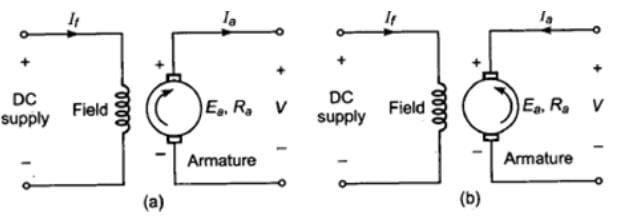
- In separate excitation, the field coils are energised by a separate DC source. The terminals of the winding can be connected across the input voltage terminals or fed from a separate voltage source.
- In self-excitation,the current flowing through the field winding is supplied by the machine itself. The field winding can be connected either in series or in parallel with the armature winding
Separately Excited DC Machine
As the name implies, the field coils are energized by a separate DC source. The armature and field winding are electrically separate from each other.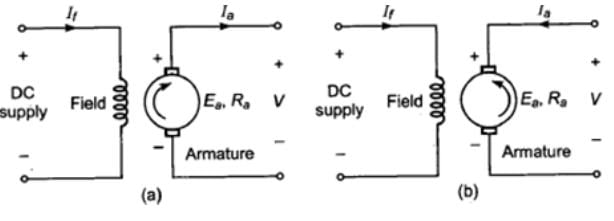
(a) Separately excited DC generator, and (b) Separately excited DC motor
Here, Ia = IL , and Ra = Armature resistance.
- For Generator
Ea = V + IaRa
or 
- For Motor
Ea = V - IaRa or
Armature power = Pa = EaIa, Output = VIL, and Armature copper loss = I2a Ra
Shunt Wound DC Machine
- The armature and field winding are connected in parallel.
- A machine in which the field coils are connected in parallel with the armature is called a shunt machine.
- The armature voltage and field voltage are the same.
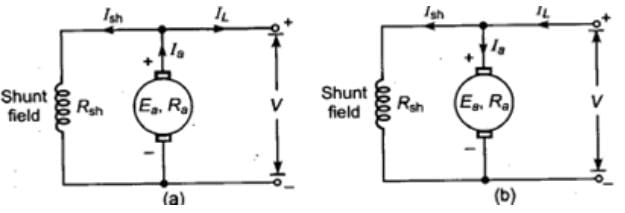
(a) Shunt wound DC generator, and (b) Shunt wound DC motor
Characteristics Equations:
where, Pa = EaIa = Armature power (developed power), I2sh Rsh = shunt field Cu loss, I2a Rsh = Armature Cu loss, and VIL = Power delivered.
Series Wound DC Machine
- A DC machine in which the field coils are connected in series with the armature is called a series machine.
- The field winding carries the same current as the armature winding.
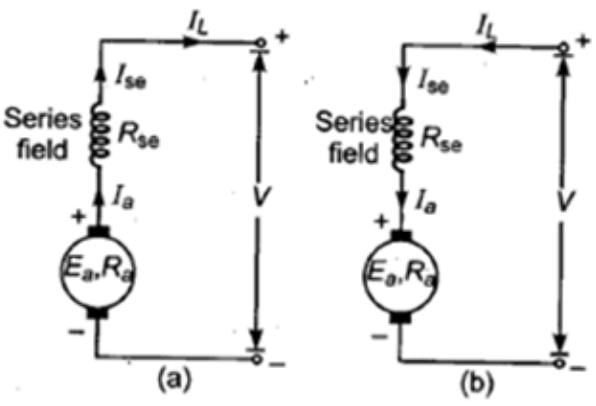
(a) DC series generator (b) DC series motor - A series wound motor is also called a universal motor. It is universal in the sense that it will run equally well using either an ac or a dc voltage source.
Characteristics Equations:
where, Pa = EaIa = Armature power (developed power), VIL = Power delivered, and I2se Rse = Series field Cu loss.
Compound Wound DC Machine
- A DC machine, having both shunt and series fields is called a compound machine.
- In a compound machine, the series field winding is connected in series with the armature, and the shunt field winding is connected in parallel.
Short-shunt compound DC Machine: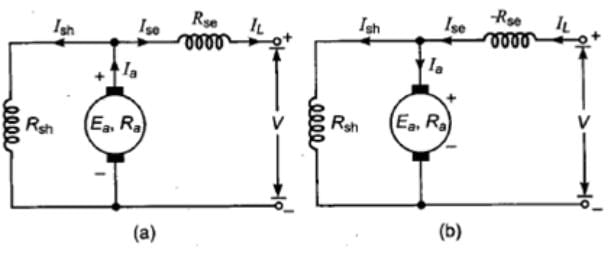
Here, Figure (a) is Short-shunt compound DC generator, and (b) is Short-shunt compound DC motor.
- For generator



- For motor


Similarly in motor,
where, Pa = Power developed, VIL = Power delivered, I2se Rse = Series field Cu loss, and I2sh Rsh = Shunt field Cu loss.
Two types of arrangements are possible in compound motors:
- Cumulative compounding : If the magnetic fluxes produced by both series and shunt field windings are in the same direction (i.e., additive), the machine is called cumulative compound.
- Differential compounding : If the two fluxes are in opposition, the machine is differential compound.
In both these types, the connection can be either short shunt or long shunt.
Long-shunt compound DC Machine: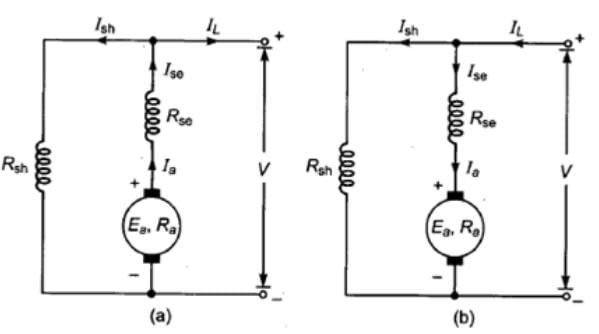
(a) Long-shunt DC generator (b) Long-shunt DC motor
- For generator



or - Similarly, in motor

where, Pa = Developed power, and VIL = Delivered power.
Power Flow In DC Machines
Here the case given to understand is for DC Motor
|
45 videos|95 docs|43 tests
|





















